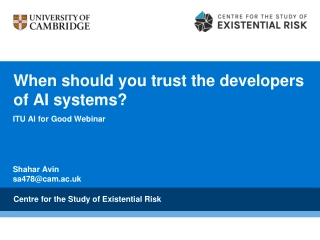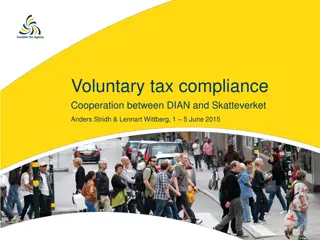
Ensuring High-Quality Data Pipeline Analysis for Reliable Experiment Results
Learn how to ensure trustworthiness and high quality in your experimentation analysis by understanding the data pipeline, analysis mechanisms, and proper interpretation of results. Discover the importance of the data pipeline in producing reliable analysis and the principle of conserving data throughout the process. Avoid common pitfalls such as missing data and explore methods to improve data matching accuracy while balancing latency. Your experiment can have a direct impact on the data pipeline, influencing outcomes like bot traffic classification.
Download Presentation

Please find below an Image/Link to download the presentation.
The content on the website is provided AS IS for your information and personal use only. It may not be sold, licensed, or shared on other websites without obtaining consent from the author. If you encounter any issues during the download, it is possible that the publisher has removed the file from their server.
You are allowed to download the files provided on this website for personal or commercial use, subject to the condition that they are used lawfully. All files are the property of their respective owners.
The content on the website is provided AS IS for your information and personal use only. It may not be sold, licensed, or shared on other websites without obtaining consent from the author.
E N D
Presentation Transcript
Ensuring Trustworthiness and High Quality PAUL RAFF SIGIR 2017 TUTORIAL 1
Objectives Understand how we deal with the analysis component of experimentation. Three main areas: The data pipeline Analysis mechanisms Proper interpretation of analysis results Ultimately, we need to ensure that what you are looking at is a proper reflection of the experiment you are running. In other words, achieving External Validity. 2
The Data Pipeline Your analysis is only as good as the data which produces it. 3
The Data Pipeline Basic Diagram A data pipeline, at its core, takes in raw events and processes them to a consumable form. Data Processing The Cooker Consumable Data Cooked Logs Raw Events 4
The Data Pipeline In reality, looks something like this How do we ensure that your data makes it out in a legitimate form? 5
No Data Left Behind Can also be called The Principle Of Conservation Of Data. Any data that enters a data pipeline should exist in some output of the data pipeline. Failure to adhere yields a version of the Missing Data Problem. 6
No Data Left Behind A common example client-side and server-side telemetry have separate raw logs. A snapshot is taken daily and joined together via a common join key. Server-side logs 08/05 08/06 08/07 08/04 Client-side logs 08/05 08/06 08/07 Client-side logs can arrive late, resulting in some of the logs not being able to be joined. 7
No Data Left Behind Incorrect (but common) method Only keeping the data each day that matches, discarding the rest. Correct methods Exposing unmatched client-side/server-side data points along with the full matched data set. Reprocessing multiple previous days together to increase the matching of the client/server data. This results in a tradeoff between data latency and completeness. 8
Your Experiment Can Influence The Data Pipeline! Primary example: bot traffic. If your treatment causes more/less traffic to be classified as bot traffic typically excluded by default in analyses then you are biasing your analysis. How to know if the data pipeline is the root cause: Be able to assess randomization as early in the data pipeline as possible, to separate out bad randomization from an issue in the data pipeline. 9
Key Mechanisms for Ensuring Trustworthiness These mechanisms fall into two forms: Global mechanisms that exist as part of your experimentation platform. Local mechanisms that exist for each individual experiment/analysis performed. 10
Global Mechanisms The All-Important AA Before you run an AB experiment, run multiple AA experiments to check: Proper randomization is done Experimentation is complete i.e. no flight assignment left behind Proper statistics are being computed ?-value distribution should be uniform Good ?-values Continuously-running AA experiments can be leveraged in numerous ways: Canary for the experimentation platform The data generated by these analyses can be used for reporting Sandbox scenario for newcomers to experimentation no risk of affecting others Bad ?-values R. Kohavi, R. Longbotham, D. Sommerfield, R. Henne, Controlled Experiments on the Web: Survey and Practical Guide," in Data Mining and Knowledge Discovery, 2009. 12
Global Mechanisms Real-time Analytics It s helpful to observe the state of each experiment as it s running, and to also continuously stress-test the assignment component. Screenshot of real-time monitoring of randomization Screenshot of real-time counters of flight assignment 13
Global Mechanisms The Holdout Experiment Experimentation incurs a cost to the system, and we can utilize experimentation itself to accurately measure the cost. Useful as a way to separate out the effect in the context of broader changes observed to the system (i.e. performance regression). Experiment 1 Holdout Experiment Experiment Space Experiment 2 User Space 14
Global Mechanisms Carry-over Effects Carry-over effects are real, and can affect your experiments if not handled appropriately. Re-randomization techniques can be used to ensure that impact from previous experiments can be distributed evenly in your new experiment. R. Kohavi, R. Longbotham, D. Sommerfield, R. Henne, Controlled Experiments on the Web: Survey and Practical Guide," in Data Mining and Knowledge Discovery, 2009. 15
Global Mechanisms Seedfinder It s known that: Observed differences between two groups 1MM randomizations 1. The measured difference between two random subsets of a population can differ over a range. 2. This difference persists over time. Therefore, we want to choose the randomization that minimizes this difference. 16
Global Mechanisms Seedfinder It s known that: 1. The measured difference between two random subsets of a population can differ over a range. We want this randomization! 2. This difference persists over time. Therefore, we want to (and can) choose the randomization that minimizes this difference. 17
Local Mechanisms Sample Ratio Mismatch chi squared test?2 test against the observed numbers to check against the experiment setup. Example data from a 50%/50% experiment note the same T/C ratio of 1.05 each time: 10 minutes 100 minutes 1K minutes 10K minutes Treatment (T) 105 1050 10500 105000 Control (C) 100 1000 10000 100000 ?-value ? = 0.7269 ? = 0.2695 ? = 0.0005 ? 0 You can only run this test against the unit you actually randomize on. If you randomize by user, you cannot test the number of events per user, as that could be influenced by the treatment effect. R. Kohavi, R. Longbotham, Unexpected Results in Online Controlled Experiments," in SIGKDD Explorations, 2009. Z. Zhao, M. Chen, D. Matheson and M. Stone, "Online Experimentation Diagnosis and Troubleshooting Beyond AA Validation," in Conference on Data Science and Advanced Analytics, 2016. 19
Local Mechanisms Data Quality Metrics As important as the Overall Evaluation Criteria are the data quality metrics that indicate issues with the data and/or the interpretation of metrics. Examples: Error rates client errors, server errors, javascript errors. Data validity rates W3C performance telemetry, for example, are delayed. If the incidence of these validity rates differ between treatments, then that invalidates the W3C metrics. Traffic/page composition rates a change in the user s initial traffic composition should be independent of the treatment effect, so any sharp changes here indicates an issue with experiment execution. Any overall changes observed can influence a lot of other metrics in the analysis. 20
Local Mechanisms Proactive Alerting Simple and effective proactive mechanism. Alert Client Error Event Rate See your scorecard ?-value Segment Precent Delta 0 Aggregate market +712.1% 0 Edge browser +1753 % 0 de-de market +157.7% Safari browser 3.7e-12 +303.2% 0 en-ca market +187.7% 0 en-gb market +638.0% 21
Local Mechanisms Treatment Effect Assessment p-hacking Simple and useful mechanism to prevent ?-hacking and fishing for statistical significance . 22
Understanding Your Metrics Keys to success: Trust, but verify: Ensure your experiment did what it was designed to do. Go a second level: Have useful breakdowns of your measurements. Be proactive: Automatically flag what is interesting and worth following up on. Go deep: Build infrastructure to find good examples. 23
Understanding Your Metrics Trust, But Verify Separate out primary effects from secondary effects. Validate your primary effects, and then analyze your secondary effects. Example: Ads. If you run an experiment to show around 10% more ads on the page, you may be tempted to look straight at the revenue numbers. Upon observing this data, you may believe that there is something wrong with your experiment. ?-value Metric Treatment Control Delta (%) Revenue Per User 0.5626 0.5716 +1.60% 0.0596 24
Understanding Your Metrics Trust, But Verify Separate out primary effects from secondary effects. Validate your primary effects, and then analyze your secondary effects. Example: Ads. If you run an experiment to show around 10% more ads on the page, you may be tempted to look straight at the revenue numbers. However, you can confirm directly that you are doing what you intended, and now you have insight! ?-value Metric Treatment Control Delta (%) 0 # of Ads Per Page 0.5177 0.4709 +9.94% Revenue Per User 0.5626 0.5716 +1.60% 0.0596 25
Understanding Your Metrics Have Useful Breakdowns This is only partially informative: ?-value Metric Treatment Control Delta (%) Overall Page Click Rate 0.8206 0.8219 -0.16% 8e-11 26
Understanding Your Metrics Have Useful Breakdowns This is much more informative. Now we can better understand what is driving the change. ?-value Metric Treatment Control Delta (%) Overall Page Click Rate 0.8206 0.8219 -0.16% 8e-11 0 - Web Results 0.5243 0.5300 -1.08% - Answers 0.1413 0.1401 +0.86% 5e-24 - Image 0.0262 0.0261 +0.38% 0.1112 - Video 0.0280 0.0278 +0.72% 0.0004 - News 0.0190 0.0190 +0.10% 0.8244 - Entity 0.0440 0.0435 +1.15% 8e-12 - Other 0.0273 0.0269 +1.49% 3e-18 0 - Ads 0.0821 0.0796 +3.14% - Related Searches 0.0211 0.0207 +1.93% 7e-26 - Pagination 0.0226 0.0227 -0.44% 0.0114 - Other 0.0518 0.0515 +0.58% 0.0048 27
Proactively Flag Interesting Things Heterogeneous treatment effects should be understood and root-caused. Typically, we expect the treatment effect to either be fully consistent over time or demonstrating a novelty effect. Sudden shifts like the one shown here indicate an externality that affected the treatment effect . 28
Go Deep Find Interesting Examples Going back to the error rate example, we can intelligently identify which errors are most likely to be causing the movements observed: Rank Error Text # - Treatment # - Control Statistic Examples 1 n.innerText is undefined 327 0 327 See examples 2 Uncaught ReferenceError: androidinterface is undefined 227 3 218 See examples 1337 FailedRequest60 3611 3853 7.8 See examples The total incidence of error may not be as important as how different it is between treatment and control. P. Raff and Z. Jin, The Difference-of-Datasets Framework: A Statistical Method to Discover Insight , Special Session on Intelligent Data Mining, IEEE Big Data 2016. 29
Summary Ensuring trustworthiness starts with your data. Numerous global and local mechanisms are available to get to trustworthy results and understand when there are issues. When analyzing your experiment results, think of the four keys to success in getting the most insight and understanding from your experiment: 1. Trust, but verify 2. Go a second level 3. Be proactive 4. Go deep 30
Appendix 31
Interesting Non-Issues Simpson s Paradox exists in various forms. Consider this real example: 32






















